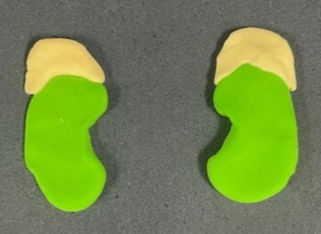Teach the Urinary System with Clay
- The Biology Buzz Place

- May 27
- 3 min read
Updated: Jun 29

Okay, here is my 4th clay model I want to share with you, just in time for summer break! Yay! This, and the other clay models I have shared with you, are perfect summer time activities to have your kids do. It took me a while to get this one up on here, as I have been super busy with other things. I actually came up with this model a year ago, yes a year ago! I definitely don't post as much as I'd like to on this site as you may already know, but here I am, taking advantage of a little free time I have right now.
I’ve already shown you how to make a neuron clay model, lung clay model, and clay blood vessels. Finally, here is one on the excretory system. You can have students make these for extra credit, or you can have it done as an in-class assignment if you have enough air-drying clay. And of course, you can have your children at home make these in the summer, for extracurricular, enrichment activities.
The urinary system is sometimes called the excretory system. It is responsible for removing wastes and excess fluids from the body. The kidneys are the main organs of the excretory system. The kidney has another role of filtering the blood, resulting in urine. Urine is a liquid waste made up of excess water, salts, and nitrogenous waste products like urea. The kidneys send the urine to the bladder via the two ureter tubes. The bladder will store the urine until it is ready to be removed from the body through the urethra. After teaching students about the function and roles of the parts of the excretory system, you can have them build this model.
The clay model will include the following components: kidneys, adrenal glands, ureters, bladder, urethra, renal artery and renal vein. I have a free digital download diagram of the excretory system in my TpT store in case a student needs help shaping the different parts of their model (It is shown below). Some of your students won’t need this though, as some will be able to mold the model parts without any assistance. If shaping the model using the worksheet template, make sure it dries for 24-48 hours before pulling it off the paper, this will ensure a clean pull off of the paper.
For this model you will need five different colors of air-dry molding clay. Any color you want to use for most of the parts is fine, but for the renal artery and renal vein you will need specific colors. You will use RED clay for the renal artery and BLUE clay for the renal vein. The renal artery is red because it carries oxygenated blood from the heart to the kidneys. It is taking blood that has wastes to the kidneys for filtration. The renal vein is blue because it is carrying deoxygenated blood. This blood has been filtered from the kidneys and is being returned to the heart.
TO BEGIN:
Give each part of the excretory system a color, as stated above. For example:
Kidneys-green
Adrenal glands-beige
Ureters- yellow
Bladder-orange
Urethra-white (or it can just be an extension of the bladder, so the same color as bladder)
Renal Artery-red
Renal Vein-blue
1. Begin by shaping the kidneys, as shown below.

Next, add the adrenal glands above each kidney as shown below.

3. Now you will roll the red clay into a renal artery and the blue clay into a renal vein.

Renal Artery 
Renal Vein 4. Now you can insert the two blood vessels (renal vein and renal artery) in between the two kidneys. Then add extensions to these blood vessels that connect them to the kidneys, as shown below. Do this to both kidneys.

5. Now you can roll two thin tubes to make the ureters. These are yellow in the picture below. Attach them to the bladder. The bladder is orange in the picture. The purple tip at the bottom of the bladder is the urethra tube where urine exits the body. Be sure to add the urethra after you make the bladder. In the end, the model should look something like the one below.

For best results, let the model dry for 24 hours or more before handling it.
I’d like to say that I am clayed out, that I have no other ideas for clay human body system, but you may know by now, that is not the case. I'll have more soon. :) In fact, I have an idea for one already. I just need to find you know what for it. Yes, you guessed it probaly..TIME! :). I hope you liked this idea. Till next time.




Comments